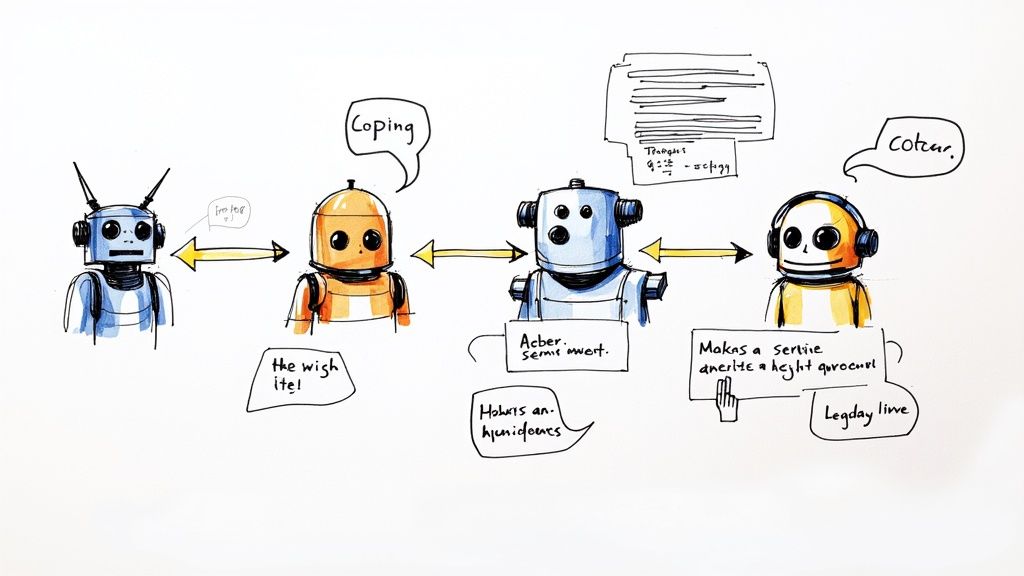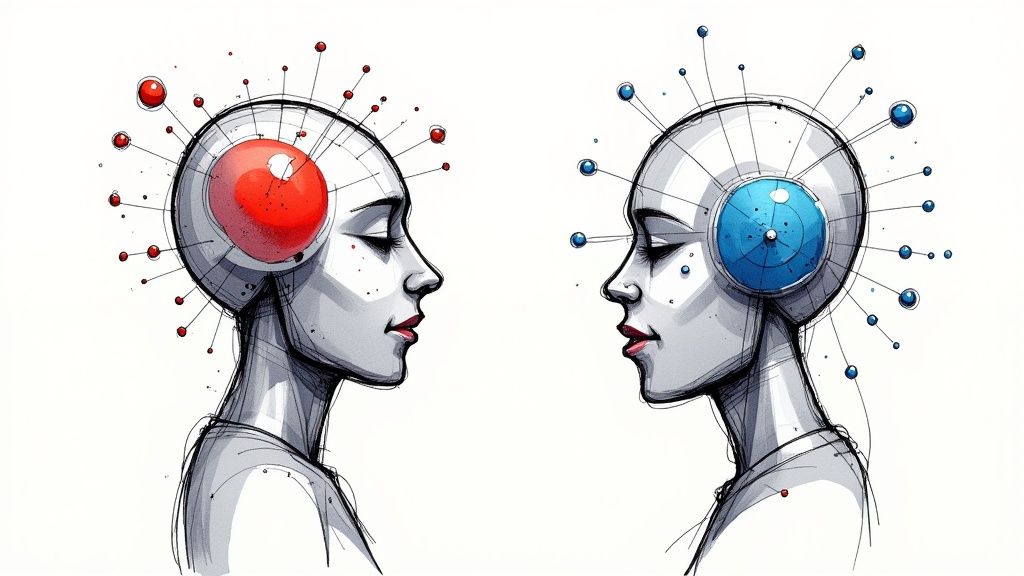Customer Service Evaluation: Proven Strategies for Success
The Real Impact of AI Chatbots on Modern Support

AI chatbots are changing how businesses handle customer support, with real evidence showing their effectiveness at helping both companies and customers. The numbers tell a clear story - about 80% of customers say they have good experiences when interacting with AI chatbots. People appreciate these tools mainly because they get fast, helpful responses.
The speed of AI chatbots is particularly impressive. They typically solve customer issues three times faster than human agents, with 90% of questions answered in under 11 messages. This quick service makes customers happy and allows support staff to focus on more complex problems that need a human touch. Getting started with AI chatbots is also straightforward - platforms like Sitebot make it simple for any business to create chatbots that match their brand and content using GPT-4 technology.
Beyond Speed: Building Trust and Enhancing Engagement
Speed is just the beginning of what AI chatbots offer. Customers are growing more comfortable with AI-powered support - as of 2024, 64% of people say they trust chatbots to help them. In fact, 55% would rather use a chatbot than wait to speak with a person. This shows how AI chatbots are becoming a normal and expected part of customer service.
The impact on business results is clear too. Companies that add AI chatbots to their customer service typically see their average order values go up by 20%, often within the first week. These results show that good chatbot service doesn't just satisfy customers - it helps drive sales. You can learn more about this in our article on revolutionizing customer service by creating your own GPT chatbot.
The Economic Advantages of AI Chatbot Integration
The business case for AI chatbots is compelling. They can handle about 30% of the work usually done by contact center employees, which could save US companies around $23 billion. This saves money while often improving service quality at the same time.
AI chatbots also help businesses handle growth better. Unlike human agents who can only talk to one customer at a time, chatbots can manage many conversations at once. This means businesses can handle busy periods smoothly without making customers wait. For support teams, this means they can spend more time on difficult cases that need their expertise, leading to better overall customer care.
Building a Business Case for AI Customer Service
Making smart decisions about AI customer service means looking closely at both financial benefits and practical concerns. When presenting the case for AI chatbots, it's essential to show clear benefits while addressing common questions from team members and leadership.
Demonstrating Return on Investment (ROI) with AI Chatbots
The numbers tell a compelling story about AI chatbot effectiveness. Research shows these tools can handle about 30% of typical contact center tasks, which adds up to major cost savings for U.S. businesses. By taking care of common questions automatically, chatbots free up human agents to focus on more challenging customer needs. This efficiency extends beyond regular business hours since chatbots work around the clock without requiring expensive night shift staffing.
But cost savings are just the beginning. Companies often see their average order values jump by 20% after adding chatbots, sometimes within just the first week. This boost comes from personalized product suggestions and active customer engagement that lead to more sales. Tools like Sitebot help track these improvements by showing exactly how customers interact with the chatbot, making it easier to fine-tune the system for better results.
Addressing Stakeholder Concerns and Building Buy-in
Some team members might worry about jobs being replaced or customer service feeling too robotic. The key is to show how AI chatbots actually make work better for everyone involved. When chatbots handle routine questions, human agents can spend more time on interesting challenges that need a personal touch. This often leads to more job satisfaction and chances to develop new skills.
It's also important to highlight how customers benefit from faster help, round-the-clock service, and personal attention from the chatbot. When customers get quick answers to simple questions, they're happier overall. Plus, human agents have more time to provide caring, detailed support when it's really needed. Sharing specific examples and data about these improvements helps convince even doubtful stakeholders that AI chatbots are worth the investment.
Practical Framework for Calculating Potential Savings
To make your case solid, start by mapping out exactly how much you could save. First, add up what you currently spend on customer service - including staff, equipment, and daily operations. Then figure out what percentage of customer questions a chatbot could answer well by looking at your most common customer requests.
Next, calculate how much you'd save on staff hours based on the tasks the chatbot would handle. Don't forget to include savings on things like phone lines or office space. Also factor in possible revenue increases from higher order values and more sales. When you put all these numbers together, you'll have a clear picture of the potential return on investment. This detailed financial breakdown gives decision-makers the concrete information they need to move forward with confidence.
Designing Customer Experiences That Actually Work

Creating great customer service with AI chatbots takes more than just adding new technology. You need to carefully map out where chatbots can help customers best and where human support makes more sense. Companies that get this right see real results - just look at H&M, which cut response times by 70% while keeping customers happy by using AI chatbots strategically.
Crafting Engaging and Effective Conversations
The way your chatbot talks to customers matters a lot. Think of it like creating a conversation guide for your friendliest customer service rep. Each chat should help solve the customer's problem while staying true to your brand's personality.
Here's what makes chatbot conversations work well:
- Keep it Simple: Use clear, everyday language and get to the point quickly. No one wants to wade through complex terms.
- Make it Personal: Reference the customer's name or past purchases when you can. Small touches like this help the interaction feel more human.
- Stay One Step Ahead: Suggest helpful next steps before customers have to ask. This shows you understand their needs.
- Switch to Humans Smoothly: When a chatbot can't help anymore, connect customers to a real person without making them repeat information. Tools like Sitebot make these handoffs feel natural.
Finding the Right Balance Between Bots and Humans
AI chatbots excel at handling everyday questions and tasks. They're great at checking order status, processing returns, and walking customers through basic troubleshooting. But they can't replace human judgment and empathy.
Use chatbots for:
- Always-On Support: Answer simple questions any time, day or night
- Quick Responses: Handle common requests fast so humans can focus on tougher issues
- Basic Information: Help customers find answers to frequent questions themselves
Save your human agents for:
- Tricky Problems: Issues that need careful thinking or deeper understanding
- Upset Customers: Situations where empathy and emotional support matter most
- Special Cases: Handling complaints or sensitive customer concerns
When you match the right tool to each task, both chatbots and human agents can do what they do best. This creates better experiences for customers and builds trust in your brand. Plus, using platforms like Sitebot lets you track what works and what doesn't through detailed data. This helps you keep improving your customer service based on real feedback and results.
Smart Implementation Strategies for Lasting Success
Building a successful AI chatbot service goes beyond basic setup. Here's a practical guide to selecting, implementing, and growing your customer service chatbot system effectively.
Choosing the Right AI Chatbot Solution
Finding the perfect AI chatbot starts with understanding your specific business requirements. Small businesses with simple websites often do well with straightforward, ready-to-use options. In contrast, large companies managing complex support workflows need platforms offering deep customization and integration capabilities. Sitebot stands out by providing both simplicity and advanced features powered by GPT-4, making it a good fit for companies at different stages of growth.
Seamless Integration with Existing Systems
Getting the most value from your chatbot means connecting it with your current tools. When your chatbot works smoothly with your CRM, helpdesk software like Zendesk, and team communication platforms like Slack, you create a complete support system. This means better data sharing, smoother customer experiences, and easier tracking of all interactions - whether they happen with the bot or human agents.
Scaling Your AI Chatbot for Growth
Your chatbot should grow alongside your business. Look for a platform that can handle more conversations without slowing down or compromising quality. As you expand, you'll need to keep building your chatbot's knowledge and training it on new types of customer questions. This helps it stay useful as your customer base grows and their needs change. Platforms like Sitebot make this growth process easier. For more details on building a scalable chatbot, check out: How to build a chatbot GPT for your business.
Training and Maintaining Conversation Quality
Running an effective chatbot takes ongoing attention. Regular updates to its knowledge base keep it current with your latest products, services, and policies. Looking at conversation logs shows you where the chatbot needs improvement. For example, if customers often get stuck on certain types of questions, that's a clear sign you need to focus training in those areas.
Ensuring Smooth Handoffs to Human Agents
While chatbots handle many routine questions well, some situations need a human touch. Creating clear guidelines for when to transfer conversations to human agents helps maintain good customer service. Make sure your agents can easily see what was discussed with the chatbot so customers don't have to repeat themselves. When done right, these transfers feel natural and keep customers happy while making support more efficient.
Creating an Effective Human-AI Support Partnership

When bringing AI chatbots into your customer service team, the focus should be on creating partnerships rather than replacements. Think of it as building a team where each member - human and AI - brings their unique strengths to serve customers better. For example, AI chatbots excel at quickly handling common questions like password resets and order tracking, which gives your human agents more time to focus on complex issues that need their expertise and emotional intelligence. This balanced approach helps both your team and your customers get the best possible results.
Training Your Team for AI Collaboration
Getting your team ready to work alongside AI requires careful planning and open communication. Start by having honest conversations about how AI chatbots will help them do their jobs better, not take them away. Show them specific examples of how handling fewer routine tasks means more time for interesting challenges and growth opportunities. Make sure everyone gets hands-on practice with platforms like Sitebot, learning exactly when and how to step in when the AI needs human backup. For more detailed guidance, check out our article on customer service training to transform your team. When agents feel confident managing these transitions, customers get smoother, more effective support.
Maintaining Employee Engagement in an AI-Driven World
It's natural for team members to worry about their roles when AI enters the picture. The key is addressing these concerns directly and showing how AI creates new opportunities. As chatbots take over repetitive tasks, agents can develop deeper product knowledge, sharpen their problem-solving abilities, and become trusted advisors to customers. This evolution of their role often leads to more job satisfaction and opens doors for career advancement. The goal is to help your team see AI as a tool that lets them focus on the most rewarding aspects of customer service.
Leveraging AI to Enhance Human Capabilities
Think of AI chatbots as powerful tools that make your human agents even better at what they do. Like having an extra set of hands, AI helps manage high volumes of basic questions while maintaining quality service standards. This frees up your team to build real connections with customers and tackle the complex issues that need human insight and empathy. AI can also give agents helpful context about customers in real-time, making it easier to offer personalized help and spot potential issues before they become problems. When humans and AI work together this way, everyone benefits - your team feels more effective, and customers get better service.
Preparing for the Next Wave of AI Support Innovation

AI chatbot technology keeps getting better with each passing day. To make the most of these advancements, businesses need to stay informed and carefully evaluate which new capabilities will truly improve their customer service. This means looking beyond flashy features to focus on changes that deliver real value.
Identifying Key Trends in AI-Driven Support
The next generation of AI support is taking shape through several important developments. Natural language processing (NLP) continues to improve, helping chatbots better grasp the nuances of human conversation. Soon, these systems will pick up not just what customers say, but also what they mean and how they feel. For example, chatbots will notice when someone is frustrated and adjust their tone accordingly. They'll also get better at detecting satisfaction levels and emotions, making interactions feel more personal and helpful.
Beyond Chat: Expanding the Scope of AI in Customer Service
AI's role in customer service is growing beyond basic chat functions. New tools can study customer behavior patterns to spot potential issues before they become problems. This shift from reactive to preventive support helps keep customers happy while reducing support requests. AI is also becoming a key part of email and social media support, creating a smooth experience no matter how customers reach out.
Future-Proofing Your Support Strategy
Success requires planning ahead. Companies should invest in flexible AI chatbot platforms like Sitebot that can grow and change with customer needs. Regular updates and improvements are essential - this means tracking how well the chatbot performs, finding ways to make it better, and using customer feedback to enhance the experience. The goal is to build a system that stays effective as technology and customer expectations change.
Strategic Frameworks for Evaluation and Adaptation
To make smart choices about AI technology, companies need clear criteria for evaluation. Key factors include: how much it costs, how well it works with existing tools, and what impact it has on customer satisfaction. Ethics also matter - businesses must ensure their AI systems are fair, open, and protective of customer privacy. Taking this balanced approach helps companies improve service while maintaining customer trust.
Ready to transform your customer service with the power of AI? Explore how Sitebot can help you build personalized, efficient, and engaging chatbot experiences that drive customer satisfaction and business growth. Get started with Sitebot today!


